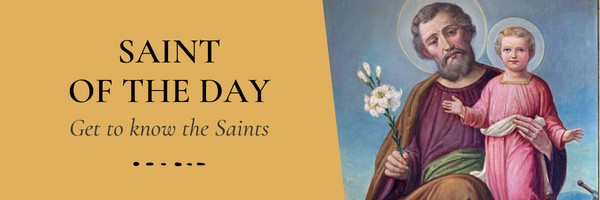We ask you, urgently: don't scroll past this
Dear readers, Catholic Online was de-platformed by Shopify for our pro-life beliefs. They shut down our Catholic Online, Catholic Online School, Prayer Candles, and Catholic Online Learning Resources essential faith tools serving over 1.4 million students and millions of families worldwide. Our founders, now in their 70's, just gave their entire life savings to protect this mission. But fewer than 2% of readers donate. If everyone gave just $5, the cost of a coffee, we could rebuild stronger and keep Catholic education free for all. Stand with us in faith. Thank you.Help Now >
Use of Beads at Prayers
FREE Catholic Classes
Beads variously strung together, according to the kind, order, and number of prayers in certain forms of devotion, are in common use among Catholics as an expedient to ensure a right count of the parts occurring in more or less frequent repetition. Made of materials ranging from common wood or natural berries to costly metals a precious stones, they may be blessed, as they are in most cases, with prayer and holy water, thereby becoming sacramentals. In this character they are prescribed by the rules of most religious orders, both of men and women, to be kept for personal use or to be worn as part of the religious garb. They are now mostly found in the form of the Dominican Rosary, or Marian Psalter ; but Catholics are also familiar with the Brigittine beads, the Dolour beads, the Immaculate Conception beads, the Crown of Our Saviour, the Chaplet of the Five Wounds, the Crosier beads, and others. In all these devotions, due to individual zeal or fostered by particular religious bodies, the beads serve one and the same purpose of distinguishing and numbering the constituent prayers.
Rationalistic criticism generally ascribes an Oriental origin to prayer beads; but man's natural tendency to iteration, especially of prayers, and the spirit and training of the early Christians may still safely be assumed to have spontaneously suggested fingers, pebbles, knotted cords, and strings of beads or berries as a means of counting, when it was desired to say a specific number of prayers. The earliest historical indications of the use of beads at prayer by Christians show, in this as in other things, a natural growth and development. Beads strung together or ranged on chains are an obvious improvement over the well-known primitive method instanced, for example, in the life of the Egyptian Abbot Paul (d. A. D. 341), who used to take three hundred pebbles into his lap as counters and to drop one as he finished each of the corresponding number of prayers it was his wont to say daily. In the eighth century the penitentials, or rule books pertaining to penitents, prescribed various penances of twenty, fifty, or more, paters. The strings of beads, with the aid of which such penances were accurately said, gradually came to be known as paternosters. Archaeological records mention fragments of prayer beads found in the tomb of the holy abbess Gertrude of Nivelles (d. 659); also similar devices discovered in the tombs of St. Norbert and of St. Rosalia, both of the twelfth century. The Bollandists quote William of Malmesbury (De Gest. Pont. Angl., IV, 4) as stating that the Countess Godiva, who founded a religious house at Coventry in 1040, donated, when she was about to die, a circlet or string of costly precious stones on which she used to say her prayers, to be placed on a statue of the Blessed Virgin. In the course of the eleventh, twelfth, and thirteenth centuries, such paternosters came into extensive use especially in the religious orders. At certain times corresponding to the canonical hours , lay brothers and lay sisters were obliged to say a certain number of Our Fathers as an equivalent of the clerical obligation of the Divine Office. The military orders, likewise, notably the Knights of St. John, adopted the paternoster beads as a part of the equipment of lay members. In the fifteenth century, wearing the beads at one's girdle was a distinctive sign of membership in a religious confraternity or third order. If a certain worldliness in the use of beads as ornaments in those days had to be checked, as it was by various capitulary ordinances prohibiting monks and friars, for instance, from having beads of coral, crystal, amber, etc., and nuns from wearing beads around the neck, evidence is not wanting that paternosters were also openly carried as a sign of penance, especially by bands of pilgrims processionally visiting the shrines, churches, and other holy places at Rome. From their purpose, too, it is natural that prayer beads were prized as gifts of friendship. They were especially valued if they had been worn by a person of known sanctity or if they had touched the relics of any saint, in which cases they were often piously believed to be the instruments of miraculous power and healing virtue.
Beads were generally strung either on a straight thread, or cord, or so as to form a circlet, or loop. At the present time chained beads have almost entirely taken the place of the corded ones. To facilitate the counting or to mark off certain divisions of a devotion, sets of beads, usually decades, are separated from each other by a larger bead or sometimes by a medal or metal cross. The number of beads on a chaplet, or Rosary, depends on the number of prayers making up each particular form of devotion. A full Rosary consists of one hundred and fifty Hail Marys, fifteen Our Fathers, and three or four beads corresponding to introductory versicles and the "Glory be to the Father", etc. Such a "pair of beads" is generally worn by religious. Lay people commonly have beads representing a third part of the Rosary. The Brigittine beads number seven paters in honour of the sorrows and joys of the Blessed Virgin, and sixty-three aves to commemorate the years of her life. Another Crown of Our Lady, in use among the Franciscans, has seventy-two aves, based on another tradition of the Blessed Virgin's age. The devotion of the Crown of Our Lord consists of thirty-three paters in honour of the years of Our Lord on earth and five aves in honour of His sacred wounds . In the church Latin of the Middle Ages, many names were applied to prayer beads as: devotiones, signacula, oracula, precaria, patriloquium, serta, preculae, numeralia, computum, calculi, and others. An Old English form, bedes , or bedys , meant primarily prayers. From the end of the fifteenth century and in the beginning of the sixteenth, the name paternoster beads fell into disuse and was replaced by the name ave beads and Rosary, chaplet, or crown.
The use of beads among pagans is undoubtedly of greater antiquity than their Christian use; but there is no evidence to show that the latter is derived from the former, any more than there is to establish a relation between Christian devotions and pagan forms of prayer. One sect in India used a chaplet consisting generally of one hundred and eight beads made of the wood of the sacred Tulsi shrub, to tell the names of Vishnu; and another accomplished its invocations of Siva by means of a string of thirty-two or sixty-four berries of the Rudrâksha tree. These or other species of seeds or berries were chosen as the material for these chaplets on account of some traditional association with the deities, as recorded in sacred legends. Some of the ascetics had their beads made of the teeth of dead bodies. Among some sects, especially the votaries of Vishnu, a string of beads is placed on the neck of children when, at the age of six or seven, they are about to be initiated and to be instructed in the use of the sacred formularies. Most Hindus continue to wear the beads both for ornament and for use at prayers. Among the Buddhists, whose religion is of Brahminic origin, various prayer-formulas are said or repeated with the aid of beads made of wood, berries, coral, amber, or precious metals and stones. A string of beads cut from the bones of some holy lama is especially valued. The number of beads is usually one hundred and eight; but strings of thirty or forty are in use among the poorer classes. Buddhism in Burma, Tibet, China, and Japan alike employs a number of more or less complicated forms of devotion, but the frequently recurring conclusion, a form of salutation, is mostly the same, and contains the mystic word OM , supposed to have reference to the Buddhistic trinity. It is not uncommon to find keys and trinkets attached to a Buddhist's prayer beads, and generally each string is provided with two little cords of special counters, ten in number, in the form of beads or metal disks. At the end of one of these cords is found a miniature thunderbolt; the other terminates in a tiny bell. With the aid of this device the devotee can count a hundred repetitions of his beads or 108 x 10 x 10 formulas in all. Among the Japanese, especially elaborate systems of counting exist. One apparatus is described as capable of registering 36,736 prayers or repetitions.
The Moslems use a string of ninety-nine (or one hundred) beads called the subha or tasbih , on which they recite the "beautiful" names or attributes of Allah. It is divided into three equal parts either by a bead or special shape or size, or by a tassel of gold or silk thread. The use of these Islamic beads appears to have been established as early as the ninth century independently of Buddhistic influences. Some critics have thought the Mohammedan chaplet is kindred to a Jewish form of one hundred blessings. The beads in general use are said to be often made of the sacred clay of Mecca or Medina. Among travellers; records of prayer beads is the famous instance, by Marco Polo, of the King of Malabar, who wore a fine silk thread strung with one hundred and four large pearls and rubies, on which he was wont to pray to his idols. Alexander Von Humboldt is also quoted as finding prayer beads, called Quipos, among the native Peruvians.
Join the Movement
When you sign up below, you don't just join an email list - you're joining an entire movement for Free world class Catholic education.
An Urgent Message from Sister Sara – Please Watch
- Advent / Christmas
- 7 Morning Prayers
- Mysteries of the Rosary
- Litany of the Bl. Virgin Mary
- Popular Saints
- Popular Prayers
- Female Saints
- Saint Feast Days by Month
- Stations of the Cross
- St. Francis of Assisi
- St. Michael the Archangel
- The Apostles' Creed
- Unfailing Prayer to St. Anthony
- Pray the Rosary
![]()
Copyright 2026 Catholic Online. All materials contained on this site, whether written, audible or visual are the exclusive property of Catholic Online and are protected under U.S. and International copyright laws, © Copyright 2026 Catholic Online. Any unauthorized use, without prior written consent of Catholic Online is strictly forbidden and prohibited.
Catholic Online is a Project of Your Catholic Voice Foundation, a Not-for-Profit Corporation. Your Catholic Voice Foundation has been granted a recognition of tax exemption under Section 501(c)(3) of the Internal Revenue Code. Federal Tax Identification Number: 81-0596847. Your gift is tax-deductible as allowed by law.








